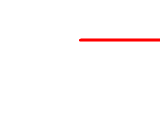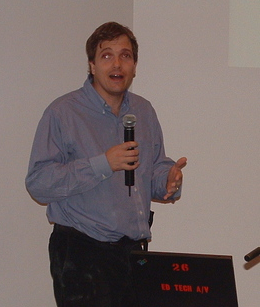Course Organization
- Overview of course content
- Instructor
- Schedule and Format
- Grade Determination
- The Book and Resources
- Other Items
Overview and Learning Objectives
This is a one semester graduate course in Classical Mechanics for incoming graduate students at Stony Brook. It is expected that student have completed undergraduate courses in advanced mechanics and two semesters of quantum mechanics. The course may be appropriate for senior undergraduate students thinking about pursuing a graduate degree in physics.
First, the course will develop the Lagrangian and Hamiltonian formalisms of classical mechanics which underlies both quantum mechanics and quantum field theory. Some classical problems, such as the motion of the planets, and their perturbations are wonderfully suited to illustrate this formalism. Next the course will study a number of problems such as non-linear oscillations and parametric resonance which are likely to occur in all fields of physics. Finally the course will study the classical mechanics of continuous systems and fluid mechanics. If time permits chaotic systems will be analyzed. Detailed lecture notes and homework problems will will be provided as the course develops.
The structure and tentative order of the course is the following
- Basic Mechanics. The Principle of least action and
the Hamiltonian formulation:
- Newton's Laws
- The action principle and Lagrange equations of motions
- The Hamiltonian formalism and the Legendre transform
- Constraints.
- Some fundamental problems of mechanics:
- Motion in one dimension
- Symmetries and Noether theorem
- Planetary motion, Rutherford scattering.
- Motion of particles in external fields
- Mechanical Oscillations:
- Normal modes, dissipation, driven systems, nonlinear oscillations, parametric resonance, the ponderamotive potential
- Rigid body motion and accelerating frames
- Tops, precession etc
- The coriolis force etc
- More about the canonical formalism, symmetries and the Hamiltonian Jacobi formalism:
- Connections to the WKB method of quantum mechanics
- Adiabatic invariance and associated problems
- Classical dynamics of continuous systems, waves on a string and membranes
- Noether theorem for continuous systems
- The canonical stress tensor
- Chaotic and non-linear dynamics
- Poincare maps
- KAM theorem
The goal of this course is for you (the student) to be able to solve physics problems associated with these topics. The homeworks are designed to help you achieve this goal. The current course will also help you prepare for the Physics Comprehensive Exam (though this is not its primary goal). A detailed list of topics on the Comprehensive Exam and some sample problems are maintained on the graduate web page graduate.physics.sunysb.edu/comprehensive.
The graphic below shows the (chaotic) motion of a double pendulum, which we will analyze at some point in the course.

Lecture Instructor:
Assoc. Professor, Derek Teaney: derek.teaney  stonybrook.edu
stonybrook.edu

Teaching Assistant: Matthew Forslund . The TA will communicate via email, matthew "dot" forslund  stonybrook.edu
stonybrook.edu
Schedules and Format
The course consists of lectures, homework, midterm and final exams, and office hours.
Lectures, class meetings, and recordings
The course consists of three in person lecture hours:
- Lecture Hours: MWF 9:15-10:10 in Engineering 143
Detailed lecture notes will be given, and the lectures will be recorded through the Echo-360 capture system. Finally a brief typed summary of the relevant formulas and concepts will be given. Thus, while the course will be delivered in person, it is hoped that a dedicated student will be able to follow the course remotely.
The last week of class (after the thanksgiving break) will be delivered remotely via zoom.
Homework submitted online:
Homework is a significant part of the course. It will be assigned approximately weekly, and students should expect to spend approximately 10 hours a week on homework. There will be approximately 10 assignments during the semester.
Homework will be collected online through blackboard. Students will need to produce a scan (of reasonable quality) of their homework, and submit it electronically as a single pdf document. Individual jpegs are not acceptable and will not be graded. For a typical student, the program CamScanner, which can be installed on any modern phone, is a useful tool to scan handwritten pages and convert them to a single pdf document.
Homework will be accepted late, but will be penalized at 5% per day.
Midterm and final exams:
The format of the midterm and final exams is not completely finalized:
- The current plan is that the final will be online using the proctoring platform recommended by SBU, which will be announced at a later date.
- The current plan is that the midterm exam will also be an online exam in roughly the middle of October. The exam will be proctored via Zoom, or other mechanism. The midterm will be two hours in duration, and will (ideally) overlap with our scheduled class period.
- I reserve the right to change the structure of the exams, depending on the evolving covid-19 pandemic and best practices. Other formats being considered are a 24 hour take home exam, and/or an oral exam.
The final exam is on Thursday evening, December 10th, 2020 from 8:30 P.M. --11:00 P.M. and will be online.
Office Hours:
Office hours will be held via Zoom at a mutually convenient time.
Technical requirements:
- Students will need to produce a scan (of reasonable quality) of their weekly homework, and submit it electronically as a single pdf document. Individual jpegsand other formats will not be accepted. For most students, the app CamScanner, which can be installed on any modern phone, is a useful tool to scan handwritten pages and convert them to a single pdf document. This can be submitted to blackboard.
- For joining office hours and the last week of classes, students will need a computer with a microphone, which are compatible with Zoom.
- For the midterm and final exams the students will need a computer with a camera and a microphone, which are compatible with Zoom.
- Classical Mechanics by Landau and Lifshitz. Wonderful book really.
- Professor Likharev's Essential Graduate Physics. Especially good treatment of oscillations which we will follow.
- Classical Mechanics by Goldstein, Safko, and Poole . A solid no-nonsense book.
Grade Determination and Homework
The grading will be based roughly on the following table. I reserve the right to change these proportions (within reasonable limits) as the course progresses to provide the best overall assessment of the class as a whole. My intent of course is to follow these guidelines.
| Homework | 20% |
| Midterm Exam | 40% |
| Final Exam | 40% |
The Book and Resources
The required book for the course is
Some other books which I used when preparing the course are:
Other Items
Required e-mail communication
Email to your University email account is an important way of communicating with you for this course. For most students the email address is firstname.lastname@stonybrook.edu. It is your responsibility to read your email received at this account.
For instructions about how to verify your University email address see this: http://it.stonybrook.edu/help/kb/checking-or-changing-your-mail-forwarding-address-in-the-epo. You can set up email forwarding using instructions here: http://it.stonybrook.edu/help/kb/setting-up-mail-forwarding-in-google-mail. If you choose to forward your University email to another account, we are not responsible for any undeliverable messages.
Student Accessibility Support Center:
If you have a physical, psychological, medical, or learning disability that may impact your course work, please contact the Student Accessibility Support Center, 128 ECC Building, (631) 632-6748, or at sasc@stonybrook.edu. They will determine with you what accommodations are necessary and appropriate. All information and documentation is confidential.
Academic Integrity:
Each student must pursue his or her academic goals honestly and be personally accountable for all submitted work. Representing another person's work as your own is always wrong. Faculty is required to report any suspected instances of academic dishonesty to the Academic Judiciary. Faculty in the Health Sciences Center (School of Health Technology and Management, Nursing, Social Welfare, Dental Medicine) and School of Medicine are required to follow their school-specific procedures. For more comprehensive information on academic integrity, including categories of academic dishonesty please refer to the academic judiciary website at http://www.stonybrook.edu/commcms/academic_integrity/index.html
Critical Incident Management:
Stony Brook University expects students to respect the rights, privileges, and property of other people. Faculty are required to report to the Office of Judicial Affairs any disruptive behavior that interrupts their ability to teach, compromises the safety of the learning environment, or inhibits students' ability to learn. Faculty in the HSC Schools and the School of Medicine are required to follow their school-specific procedures.Further information about most academic matters can be found in the Undergraduate Bulletin, the Undergraduate Class Schedule, and the Faculty-Employee Handbook.